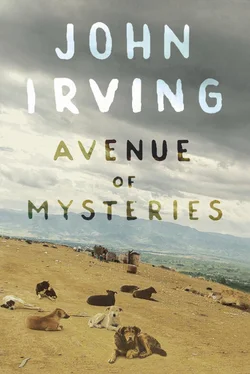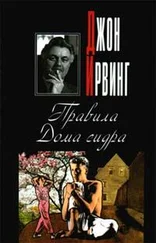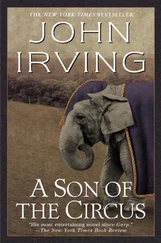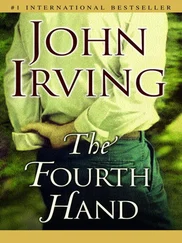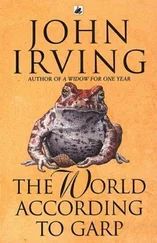“What do the Germans have to do with it?” Lupe asked. “Either Guadalupe is a miracle or she isn’t. It’s not about the cloak !”
The Basílica de Nuestra Señora de Guadalupe was, in fact, a group of churches, chapels, and shrines all gathered on the rocky hillside where the miracle supposedly occurred. As it would turn out, Edward Bonshaw and the dump kids saw only the Chapel of the Well, where Guadalupe lay under glass on her deathbed, and El Cerrito de las Rosas. (They would never see the enshrined cloak.)
Inside El Cerrito, it’s true that the Virgin of Guadalupe isn’t tucked away in a side altar; she is elevated at the front of the chapel. But so what if they’d made her the main attraction? They had made Guadalupe at one with the Virgin Mary; they’d made them the same. The Catholic hocus-pocus was complete: the sacred Of the Roses was a zoo. The crazies far outnumbered the worshipers who were trying to follow the Mass-in-progress. The priests were performing by rote. While the megaphone was not permitted inside the temple, the tour guide continued in Japanese to the honeymooners in their surgical masks. The roped-together men in business suits — their blindfolds were once more removed — stared unseeing at the dark-skinned virgin, the way Juan Diego stared when he was dreaming.
“Don’t touch those ashes,” Lupe said to him, but Juan Diego was holding the lid tightly in place. “Not a speck gets sprinkled here,” Lupe told him.
“I know—” Juan Diego started to say.
“Our mother would rather burn in Hell than have her ashes scattered here,” Lupe said. “El gringo bueno would never sleep in El Cerrito — he was so beautiful when he slept,” she said, remembering. It wasn’t lost on Juan Diego that his sister had stopped calling the temple “Of the Roses.” Lupe was content to call the temple “The Little Hill”; it wasn’t so sacred to her anymore.
“I don’t need a translation,” Señor Eduardo told the dump kids. “This chapel is not holy. This whole place is not right — it’s all wrong, it’s not the way it was meant to be.”
“Meant to be,” Juan Diego repeated.
“It’s neither animal, vegetable, nor mineral — it’s like the German said!” Lupe cried. Juan Diego thought he should translate this for Edward Bonshaw — it had a disturbing ring of truth to it.
“ What German?” the Iowan asked, as they were descending the stairs. (Years later, Señor Eduardo would say to Juan Diego: “I feel I am still leaving The Little Hill of the Roses. The disillusion, the disenchantment I felt when I was descending those stairs, is ongoing; I am still descending, ” Edward Bonshaw would say.)
As the Iowan and the dump kids descended, more sweaty pilgrims pressed and bumped against them, climbing to the hilltop site of the miracle. Juan Diego stepped on something; it felt a little soft and a little crunchy at the same time. He stopped to look at it — then he picked it up.
The totem, slightly larger than the finger-size suffering Christs that were everywhere for sale, was not as thick as Lupe’s rat-size Coatlicue figurine — also everywhere for sale in the compound of buildings comprising the vast Basílica de Nuestra Señora de Guadalupe. The toy figure Juan Diego had stepped on was of Guadalupe herself — the subdued, passive body language, the downcast eyes, the no-breasts chest, the slight bulge where her lower abdomen was. The statuette radiated the virgin’s humble origins — she looked as if she spoke only Nahuatl, if she spoke at all.
“Someone threw it away,” Lupe said to Juan Diego. “Someone as disgusted as we are,” she said. But Juan Diego put the hard-rubber religious figure in his pocket. (It wasn’t as big as the Virgin Mary’s nose, but it still made his pocket bulge.)
At the bottom of the stairs, they passed through a gauntlet of snack and soft-drink salesmen. And there was a group of nuns, selling postcards to raise money for their convent’s relief of the poor. Edward Bonshaw bought one.
Juan Diego was wondering if Señor Eduardo was still thinking about the postcard of Flor with the pony, but this postcard was just another Guadalupe photo — la virgen morena on her deathbed, encased in glass, in the Chapel of the Well.
“A souvenir,” the Iowan said a little guiltily, showing the postcard to Lupe and Juan Diego.
Lupe looked only briefly at the photo of the dark-skinned virgin on her deathbed; then she looked away. “The way I feel right now, I would like her better with a pony’s penis in her mouth,” Lupe said. “I mean dead, but also with the pony’s penis,” Lupe added.
Yes, she’d been asleep — with her head in Señor Eduardo’s lap — when the Iowan told Juan Diego the story of that terrible postcard, but Juan Diego had always known that Lupe could nonetheless read minds when she was asleep.
“What did Lupe say?” Edward Bonshaw asked.
Juan Diego was looking for the best way to escape from the enormous flagstoned plaza; he was wondering where the taxis were.
“Lupe said she’s glad Guadalupe is dead — she thinks that’s the best part of the postcard,” was all Juan Diego said.
“You haven’t asked me about the new dog act,” Lupe said to her brother. She stopped, as she had before, waiting for him to catch up to her. But Juan Diego would never catch up to Lupe.
“Right now, Lupe, I’m just trying to get us out of here,” Juan Diego told her irritably.
Lupe patted the bulge in his pocket, where he’d put the lost or discarded Guadalupe figure. “Just don’t ask her for help,” was all Lupe said.
“Behind every journey is a reason,” Juan Diego would one day write. It had been forty years since the dump kids’ journey to the Guadalupe shrine in Mexico City, but — as Señor Eduardo would one day put it — Juan Diego felt he was still descending.
“I’m always meeting people in airports,” was the innocent-sounding way Dorothy began her fax to Juan Diego. “And, boy, did this young mother need help! No husband — the husband had already dumped her. And then the nanny abandoned her and the kids at the start of their trip — the nanny just disappeared at the airport!” was how Dorothy set the story in motion.
The long-suffering young mother sounds familiar, Juan Diego was thinking as he read and reread Dorothy’s fax. As a writer, Juan Diego knew there was a lot in Dorothy’s story; he suspected there might be more that was missing. Such as: how “one thing led to another,” as Dorothy would put it, and why she’d gone to El Nido with “poor Leslie,” and with Leslie’s little kids.
The poor Leslie part rang a bell with Juan Diego, even the first time he read Dorothy’s fax. Hadn’t he heard about a poor Leslie before? Oh, yes, he had, and Juan Diego didn’t need to read much more of Dorothy’s fax before he was reminded of what he’d heard about poor Leslie, and from whom.
“Don’t worry, darling — she’s not another writer!” Dorothy had written. “She’s just a writing student — she’s trying to be a writer. In fact, she knows your friend Clark — Leslie was in some sort of workshop at a writers’ conference where Clark French was her teacher.”
So she was that poor Leslie! Juan Diego had realized. This poor Leslie had met Clark before she’d taken a writing workshop with him. Clark had met her at a fund-raising event — as Clark had put it, one of several Catholic charities he and poor Leslie supported. Her husband had just left her; she had two little boys who were “a bit wild”; she thought the “mounting disillusionments” in her young life deserved to be written about.
Читать дальше
